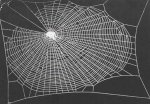Caffeine
This week I want to raise the issue of caffeine with you. I am going to include a section from the new book, Little Sugar Addicts. It will be less scary if I am talking about your children than about you. (smile)
I think the most compelling evidence about the impact of caffeine on your child’s brain comes from the work of Peter DeWitt who gave a group of spiders different drugs in the late 60s. DeWitt found the spiders that make what is called an orb web. It is beautiful, highly regular and predictable and can be easily photographed.
 |
Here is a picture of a normal happy orb spider web with no drugs. The soda industry has not found this little spider yet. |
 |
Now take a look at the picture of the spider on caffeine |
Sort of stops you cold, doesn’t it? Think about the implications of this for your child’s brain. Think of the impact on his ability to function in school. Sure made me think some.
The key part of the caffeine story is the level of the “dose” based on your child’s weight. A can of soda for you is not the same as a can of soda for your child. A 12 oz. can of Coke has 35 mg of caffeine (Diet Coke has 45). If you put 35 mg of caffeine into a body that weigh 180 pounds, it diffuses a whole lot more than if you put it into a body that weighs 60 or 40 pounds. Basically, the same size can of soda can have 3 times more effect on your child than it does on you. Think about that spider web picture when you think about the dose impact on your child.
As you think about caffeine, remember that it is found not just in coffee and soda. Here is a list that gives you a sense of the relative value of caffeine in foods and drinks I am going to include some things like Starbucks drinks because I have noticed so many children now drinking Starbucks specialty drinks.
|
Product
|
Caffeine
|
|
Coffee, Grande
(16 oz), Starbucks
|
550
|
|
Cafe
Americano, short (8 oz) Starbucks
|
35
|
|
Coffee, tall
(12 oz) Starbucks
|
375
|
|
Cafe Mocha,
tall (12 oz) Starbucks
|
35
|
|
7-eleven big
gulp cola (64 oz)
|
190
|
|
Cola (12 oz)
|
35
|
|
Mountain Dew
(12 oz)
|
55
|
|
Diet Coke
|
45
|
|
Mello Yello
|
51
|
|
Nestea sweet
|
26
|
|
A & W
creme soda
|
29
|
|
Dr. Pepper
|
41
|
|
Sun Drop
regular
|
63
|
|
Sun drop Diet
|
69
|
|
Sunkist orange
soda
|
41
|
|
Pepsi
|
38
|
|
Pepsi 1
|
55
|
|
Royal Crown
Cola
|
43
|
|
RC edge
|
70
|
|
Snapple (16
oz)
|
48
|
|
Arizona Iced
Tea (16 oz
|
15-30
|
|
Java Water
(1/2 liter)
|
125
|
|
Juiced
|
60
|
|
Haagen Dazs
Coffee Ice cream (1 cup)
|
58
|
|
Dannon Coffee
yogurt
|
45
|
|
Hershey special
dark chocolate
|
31
|
As you look at these, you can begin to see that yes, they can have a real impact on your child. If caffeine is a drug that peaks in 3-7 hours, it is reasonable to assume that your child will experience drug withdrawal at the earlier end of that scale. So you may have a child in caffeine withdrawal who is edgy, irritable, cranky and with a headache. So he can’t sit still and is whining. You think he is a bad boy. He gets the message he is bad boy and begins to think of himself that way. And the real thing that is going on is a biochemical reaction to the drug.
I strongly encourage parents to get their children off of caffeine. Do not give your children drinks and foods with caffeine in them. If your child is currently using caffeine, do not stop it abruptly. Going off of the drug should be done through what we call a taper process. This means cutting down over time. The first task is knowing the current level of using it. Figure out how much caffeine your child is getting. Use the same process you have been using all along. Do this with your child. Cut down over a 2 week period. If you child has caffeine soda intermittently, you can simply stop and say we aren’t doing that kind any more. Start with this before you think about the rest of the program for your kids. And come join the parents list if you would like to learn more.
(c)Kathleen DesMaisons 2006. All rights reserved.
|
